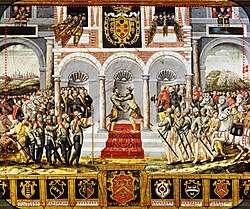Peace of Cateau-Cambrésis
The Peace of Cateau-Cambrésis were two peace treaties concluded in 1559 in Cateau-Cambrésis , southeast of Cambrai , between Henry II of France , Philip II of Spain and Elizabeth I of England . The peace ended the Franco-Spanish dispute for supremacy in Europe , especially in Italy .
First treaty: France and England
The first treaty of March 12 and April 2, 1559 was concluded between King Henry II of France and Queen Elizabeth I of England. For a payment of 500,000 écu , France retained Calais, which had been retaken in January 1558 .
Second treaty: France and Spain
The second treaty of April 3, 1559 was concluded between King Henry II of France and Philip II of Spain.
The French king renounced all claims in Italy , but kept the three dioceses of Metz , Toul and Verdun occupied in 1552 .
Philip II received his territories in Italy and the Burgundian possessions confirmed. France had to forego its war aims and return Thionville , places in Luxembourg , Marienburg , Yvoix , Damvillers , Montmédy and areas in Artois and Charolais to Spain .
The seized property was returned to the Duchy of Savoy , which was almost completely annexed by France in 1536, especially the transalpine part with the former capital Chambéry and the Alpine passes .
The contract was confirmed by two marriages: the daughter of Henry II, Elisabeth von Valois , married Philip II, Henry's sister Margarete married Emmanuel Philibert of Savoy . A few weeks after the contract was signed, Heinrich II died of the consequences of a tournament accident . The tournament took place on the occasion of the peace treaty.
Effects
With the Peace of Cateau-Cambrésis, France retired as a dominant power for forty years , thus enabling the Spanish supremacy of Philip II and the Habsburgs in Europe. The King of France was initially anxious to resolve his internal conflicts with the emerging Protestantism ( Huguenot Wars ) and wanted to negotiate a peace that would secure him in terms of foreign policy. The internal consolidation, however, was to last until 1598, as a result of which Henry IV again pushed an offensive policy against the House of Habsburg.
literature
- Alphonse de Ruble : Le traité de Cateau-Cambrésis (2 and 3 avril 1559). Labitte, Paris 1889 ( digitized in the Internet Archive ).
- Joycelyne G. Russell: Peacemaking in the Renaissance. University of Pennsylvania Press, Philadelphia 1986, ISBN 0-8122-8030-X , Chapter 5: The Peace of Cateau-Cambresis. Negotiations at Cercamp, October – December 1558 , and Chapter 6: The Peace of Cateau-Cambresis. Negotiations at Le Cateau, February – April 1559 ( review ).
- Sven Externbrink : Le Coeur du monde. France and the northern Italian states (Mantua, Parma, Savoy) in the age of Richelieu 1624–1635 (= history. Vol. 23). Lit, Münster 1999, ISBN 3-8258-4390-4 , also dissertation, University of Marburg, 1997, p. 193 .
- Rainer Babel : Germany and France under the sign of the Habsburg universal monarchy, 1500–1648 (= WBG German-French History. Vol. 3). Wissenschaftliche Buchgesellschaft, Darmstadt 2005, ISBN 3-534-14701-4 , chapter The Empire and the Franco-Habsburg War up to the Peace of Cateau-Cambrésis. Pp. 51-56.
- Ana Díaz Serrano, José Javier Ruiz Ibáñez: Cateau-Cambrésis, 1559: ¿hacia una Europa confesional o hacia la hegemonía de la Monarquía Hispánica? In: Pedralbes. Revista d'historia moderna. ISSN 0211-9587 , Vol. 29, 2009, pp. 63-94 ( PDF ).
- Bertrand Haan: Une paix pour l'éternité. La negociation du traité du Cateau-Cambrésis (= Bibliothèque de la Casa de Velázquez vol. 49). Droz, Geneva 2010, ISBN 978-84-96820-48-7 ( preview at Google Books; review at Sehepunkte , review at Francia ).
- Alfred Kohler : From the Reformation to the Peace of Westphalia (= Oldenbourg ground plan of history . Vol. 39). Oldenbourg, Munich 2011, ISBN 978-3-486-59803-2 , p. 70 .
Web links
- Glossary entry at historicum.net .
- 1559 IV 1 article by Cateau-Cambrésis regarding the marriage between Margaret of France and Emanuel Philibert of Savoy. Contract text. Leibniz Institute for European History . Retrieved June 25, 2016 .
- 1559 IV 3 Peace Treaty of Cateau - Cambrésis. Contract text. Leibniz Institute for European History . Retrieved June 25, 2016 .
